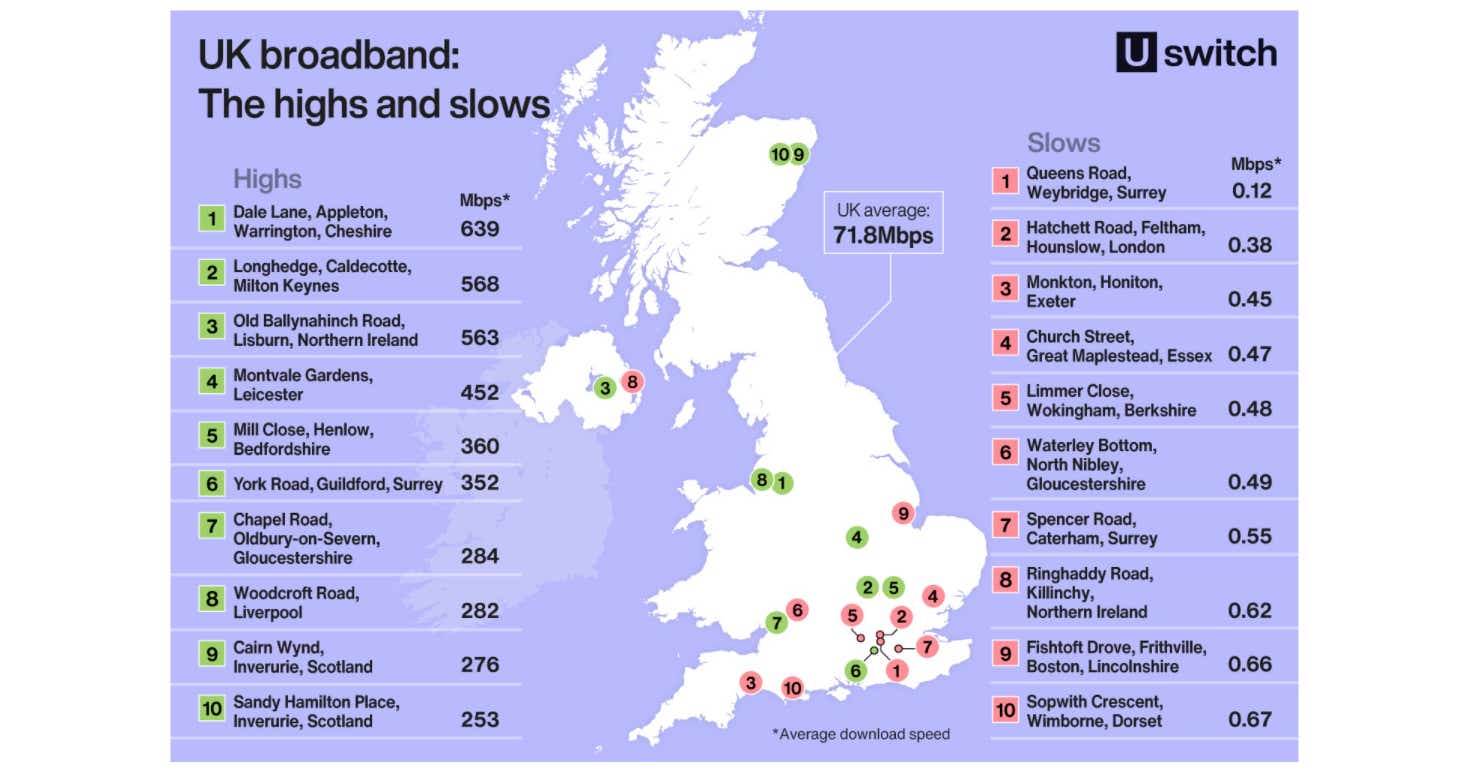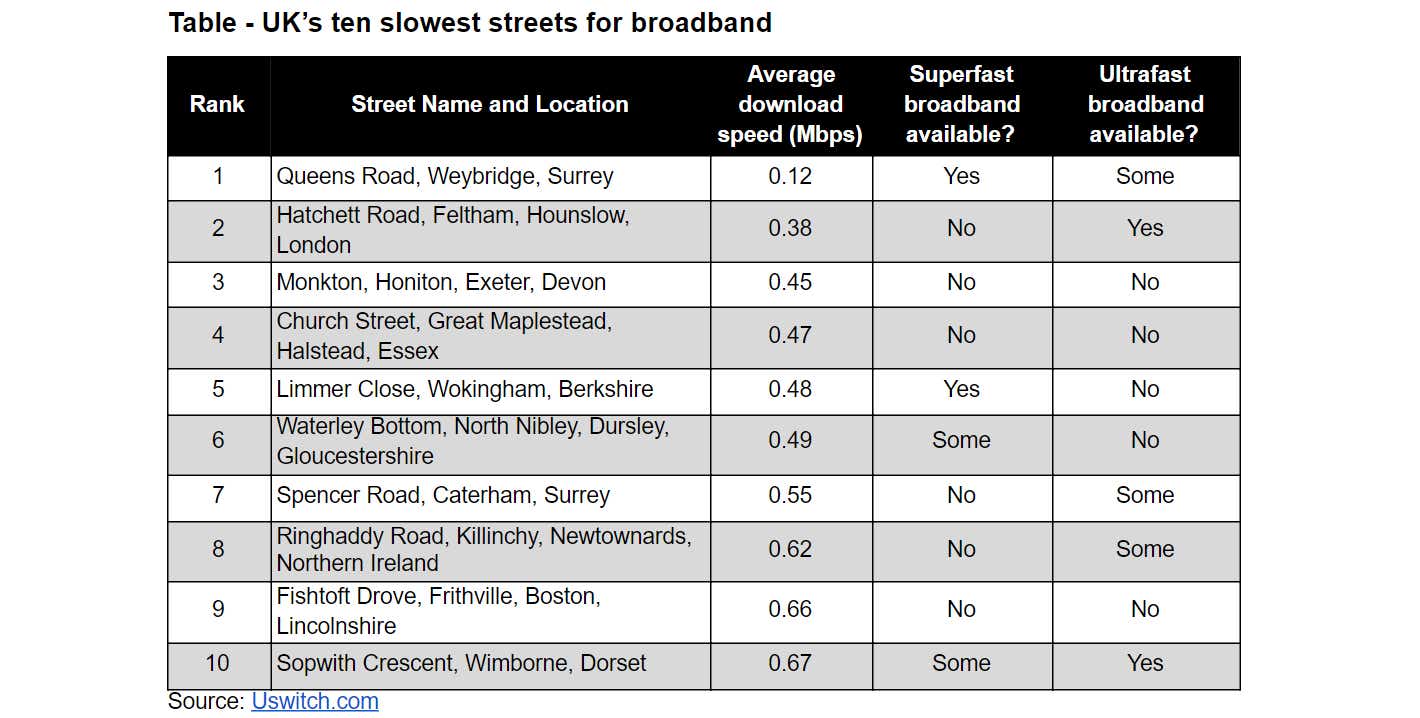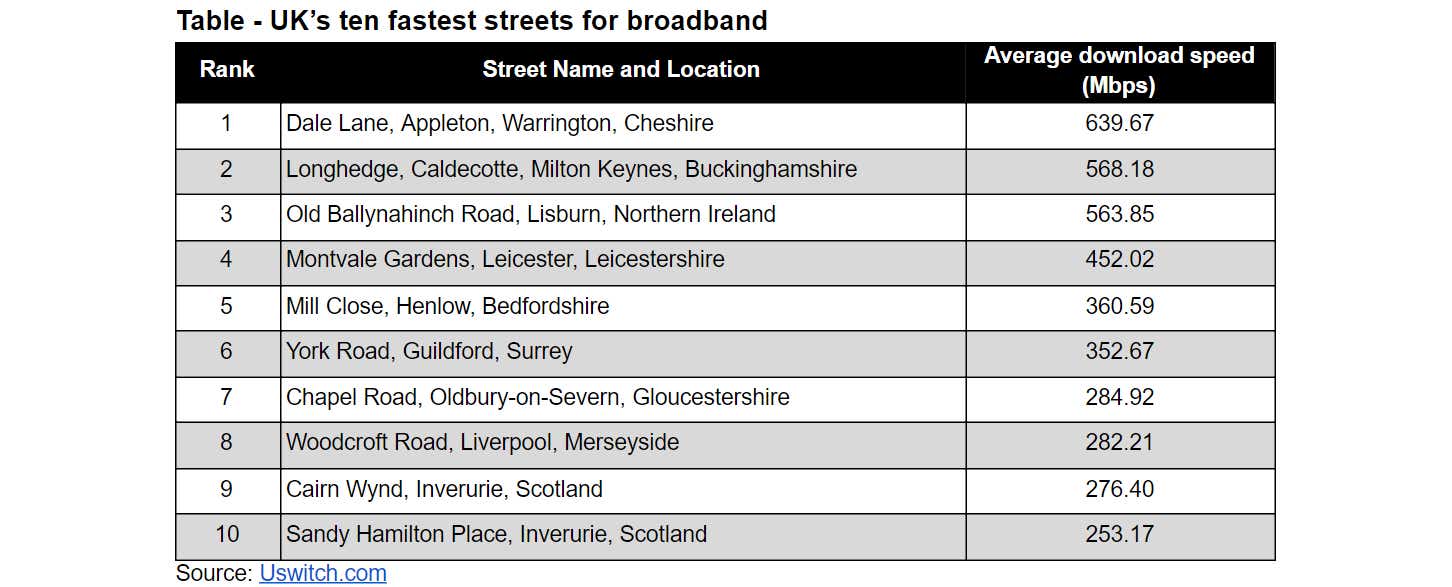Queens Road in Weybridge, Surrey, is crowned the UK’s slowest street for broadband — with average download speeds of 0.12Mbps[1]
This is 5,330 times slower than Dale Lane in Appleton, Cheshire, which boasts average speeds of 639.67Mbps[2]
Last year, the fastest street was only 830 times quicker than the slowest, suggesting the rise of ultrafast broadband is increasing the UK’s digital divide[3]
Seven of the ten slowest streets with speeds below 1Mbps could actually get broadband of at least 30Mbps if they upgraded their service[4]
Nearly 400,000 speed tests recorded — a 225% increase on last year — as locked-down households became ever more reliant on their home broadband
Uswitch.com urges frustrated consumers to check what speeds they are getting and see if quicker broadband is available.
The slowest broadband in the UK, with an average download speed of 0.12Mbps, is found in Queens Road, Weybridge in Surrey, according to analysis of a record-breaking 398,973 consumer speed tests collated by Uswitch.com, the comparison and switching service.
Sluggish-paced Queens Road is a staggering 5,330 times slower than the UK’s fastest street, Dale Lane in Appleton, Cheshire, where average speeds reached 639.67Mbps over the past year[2].
Last year the worst street was only 830 times slower than the fastest street[3], suggesting that Britain’s digital divide is growing with the rollout of full fibre broadband (FTTP) that is bringing ultrafast speeds to parts of the country[5].

It would take the unfortunate residents of Queens Road more than 119 hours to download a two-hour HD film and at least 44 hours to download a 45-minute HD TV show. By contrast, the people of Dale Lane would take just one minute and 20 seconds to download the same film or a mere 30 seconds to download the same show[6].
The slowest and fastest UK streets have been revealed by more than 398,973 ‘real world’ speed tests run by broadband users over the last year. The number of speed tests is up 225% on last year’s tally of 122,845, with the dramatic rise suggesting that consumers have been paying closer attention to the performance of their home broadband during lockdown[3].
The good news is that the number of broadband users enjoying faster speeds is growing. More than half of users (54%) now get speeds of more than 30Mbps, up from under a quarter (22%) five years ago[7]. But despite the fact that superfast broadband (downloads speeds of 30Mbps or more) is available to 95%[8] of the country, a recent Uswitch survey found that only six in ten (60%) believe they can access it in their local area[9].
For many, it’s a story of the broadband haves and have-nots living side by side. In Surrey, residents on Woodcote Lane, Purley, enjoy ultrafast speeds of 206.45Mbps, while one of the country’s worst streets, Spencer Road in Caterham, is just 17 minutes’ drive away — with download times 372 times slower at 0.55Mbps[10].
Further reinforcing a lack of awareness of the faster speeds available, of the ten slowest streets, seven (70%)[4] have access to a quicker service, suggesting that consumers are being deprived of better broadband simply because they aren’t checking.


Ernest Doku, broadband expert at Uswitch.com, says: “The digital divide that runs through Britain has grown dramatically in the last year, with the fastest street’s broadband more than 5,000 times quicker than the slowest’s.
“It’s interesting to see that the North claims the fastest street this year, while the slowest street is in the South East, showing that the speed of your connection has nothing to do with where you live.
“It’s great that more of us are enjoying ultrafast broadband, but we don’t want to see large swathes of the country left behind on shoddy connections that aren’t suitable for modern life.
“With millions of us working from home and watching more streaming TV at the moment, a good broadband connection is more important than ever.
“One of the biggest obstacles stopping people from getting faster downloads speeds is the lack of awareness regarding superfast and ultrafast broadband.
“For example, some people on the UK’s fastest street, Dale Lane, enjoy speeds above 900Mbps, while others only get 5.5Mbps.
“And of the ten slowest streets, seven could have access to faster broadband, so we urge residents there — and anyone else unhappy with their broadband speeds — to do a quick check online to see what speeds they could be getting.”
Anyone frustrated with their broadband service can test what speed they’re getting at www.uswitch.com/broadband/speedtest
FOR MORE INFORMATION
Rory Stoves
Phone: 020 3872 5613
Email: rory.stoves@uswitch.com
Twitter: @UswitchPR
Notes to editors
Broadband users ran a total of 398,973 consumer speed tests during the 12-month period 1st October 2019 to 30th September 2020 inclusive, using Uswitch.com’s free speed testing tool.
We took the slowest and fastest postcodes from the 398,973 speeds tests within 155,217 postcodes. In order for a street to qualify for inclusion in the top or bottom 30, tests from at least three unique IP addresses and at least ten residential properties were required at a postcode.
1. See tables of UK’s ten slowest and ten fastest streets for broadband
2. Fastest street in the UK is Dale Lane (639.67Mbps) and the slowest street is Queens Road (0.12Mbps). Calculation: 639.67/0.12 = 5,330.6
3. Uswitch: The UK streets with the slowest broadband speed
4. Out of the UK’s ten slowest streets seven of them have access to either superfast or ultrafast (fibre to the premises (FTTP)) broadband (70%)
5. UK Government: Building Digital UK
6. Calculated using this online tool: https://www.download-time.com File sizes: average 2-hour HD film on Netflix is 6GB, average HD 45-minute TV show on Netflix is 2.25GB
7. Based on 1,030,865 consumers’ tests taken during the six-month period Aug 2014-Feb 2015. More details can be found here.
8. Ofcom Connection Nations 2020
9. Uswitch.com surveyed a sample of 3,000 UK adults (aged 18+) from 18th to 23rd September 2020. Results have been weighted to nationally representative criteria. Respondents were asked: ‘Do you know if it is possible to get superfast broadband in your postcode?’ The net response for ‘yes’ was 60%
10. Uswitch.com analysis of speed data
About Uswitch
Uswitch is one of the UK’s top comparison websites for home services switching, including energy, broadband and mobiles.
More people go to Uswitch to switch their energy, broadband and mobile than any other site, and we have saved consumers over £2.7 billion off their bills since we launched in September 2000.
Free mobile app Utrack also helps households manage their home energy usage and make potential savings.
Uswitch is part of RVU, a group of online brands with a mission to empower consumers to make more confident home services, insurance and financial decisions.
